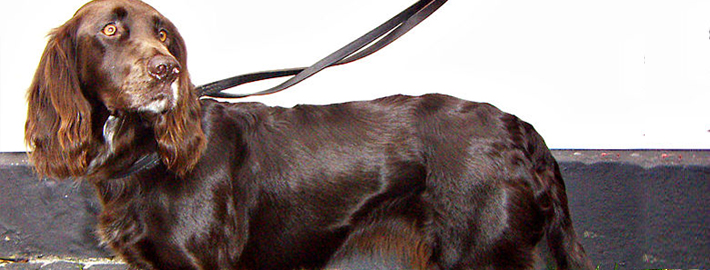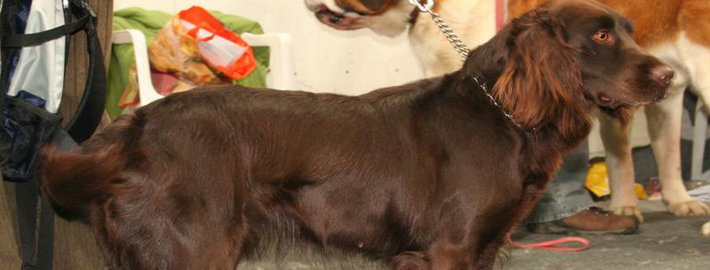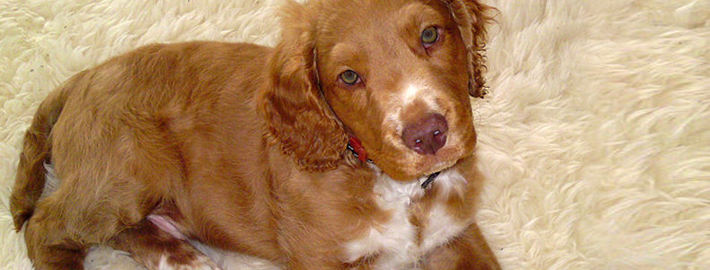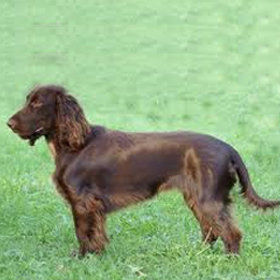What makes the eGerman Spaniel Unique?
The Deutscher is an exceptional versatile gundog. It is used to hunt upland game, will match the retrieving ability of any other breed and excels at tracking and blood trailing large game. It is an all-around bird dog and will hunt all other types of game. It has a vibrant, friendly personality, it is an intelligent, aggressive hunter, and loves water work.
Breed Groups
Page Contents
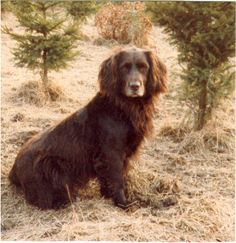
SnapShot
| Size: | Males – 46 to 54 cm (18 to 21 inches) Females – 44 to 52 cm (17 to 20 inches) |
| Weight: | Males – 27 to 42 kg (44 to 66 pounds) Females – 27 to 42 kg (44 to 66 pounds) |
| Origin: | Germany |
| Life Span: | 12 – 14 Years |
| Colour: | Solid Brown/red; Roan (brown and white or red and white) |
| Litter Size: | up to 8 puppies |
Is the German Spaniel Right For You?
In 5 Words
- Attentive
- Vibrant
- Friendly
- Vigilant
- Intelligent
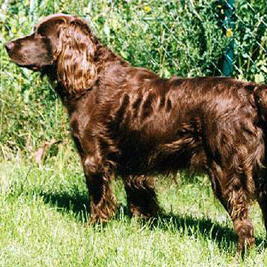
Characteristics
Learn About the German Spaniel
Description
General Description
The Deutscher Wachtelhund is a strong boned, muscular, medium sized gundog with long thick wavy hair. It is solidly-built which allows it to retrieve heavy game such as hares and foxes. The ears are fairly long and should reach from half way to the nose, to the tip of the nose. The size is approximately 18–21 inches (46–53 cm) at the withers.[1] Body length, from the nose to the base of the tail is twice the length of the dogs height. Average weight for both males and females of the breed is between 44–66 pounds (20–30 kg).
The coat is short and fine on the head, and of long on the body, where it is strong, thick, wavy or curly, with enough undercoat to provide protection. It has a well feathered coat which is usually either brown or brown roan. Although brown, it can have white markings chest and/or legs, and may have white ticking anywhere on its body. Other colors that the coat can come in include red and white, and solid red. Plain black coats do not occur in the breed.
Short History of the German Spaniel
The German Spaniel is truly versatile hunting dog that is capable of scenting, tracking and retrieving various types of game. It also can work on different kind of terrain including land and swampy areas. In Germany it’s eligible to keep the dog only for hunters and gamekeepers so it can’t be sold to public. In the late 60s and early 70s of the XX century the breed was imported to the United States but it didn’t acquire much popularity there. Nowadays there are roughly 100 dogs in the USA and Canada.
The German Spaniel was approved by the American Kennel Club (AKC) in 1992. Four years later the United Kennel Club (UKC) granted its full recognition to the breed.
Temperament
The Deutscher is an exceptional versatile gundog. It is used to hunt upland game, will match the retrieving ability of any other breed and excels at tracking and blood trailing large game. It is an all-around bird dog and will hunt all other types of game. It has a vibrant, friendly personality, it is an intelligent, aggressive hunter, and loves water work. It has the scent following ability of a Bloodhound, birdiness guaranteed. Needs a firm, but calm, confident and consistent owner who has an air of natural authority to them. Proper canine to dog communication is essential.
Caring for Your German Spaniel
General Health
Hip dysplasia is not normally a problem in the breed. In Germany breeders must request permission from the German Wachtelhund Club to breed their Wachtelhunds. Prior to this the Wachtelhund must have passed ten specific hunt measurement tests and the breeder must provide X-rays of the female and male, with a vet’s certification that the Wachtels do not have hip dysplasia. The Germans rate hip dysplasia on a scale of 0 through 4. Three and 4’s are not breedable. In the States, most breeders have had their Wachtelhunds certified by the OFA as being free of hip dysplasia. OFA rates hip excellent, good, fair and poor. Wachtelhunds with fair and poor ratings should not be bred. Buyers should request the rating from the breeder and not buy dogs coming from parents with fair to poor ratings. Crooked legs and splayed feet are a problem; again buyers should avoid buying pups from parents with these conditions. Another problem are dogs with skin conditions or allergies; they should not be bred.
Grooming & Bathing
The coat needs to be brushed regularly and bathed occasionally.
Exercise & Training
German Spaniels need firm, consistent training. They love water and are excellent retrievers, so frequent swimming is great exercise. They will go into water right up to freezing and immediately after the ice breaks up. They are not the dog for an occasional hunter. On days you do not take them hunting, they need a daily, brisk, long walk or jog where the dog is made to heel beside or behind the person holding the lead, as instinct tells a dog that the leader leads the way, and that leader needs to be the human.

